Dalībnieks:Kode/Darbs 2
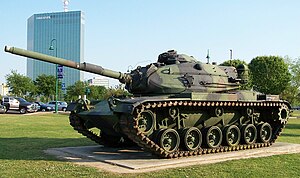
Tanks ir bruņota kāpurķēžu kaujas mašīna, kas paredzēta piefrontes kara operācijām. Kā galvenais ierocis visbiežāk tiek lietots lielgabals, kas uzstādīts rotējošā tornī, nodrošinot izcilu ugunsjaudu plašos attālumu diapazonos. Aizsardzību no vairuma mūsdienu šaujamieroču un munīcijas, tankam nodrošina galveno konstrukcijas elementu bruņojums.
Pirmie tanki tika uzbūvēti I. pasaule kara laikā lai izietu no bezizejas stāvokļa kas radās tranšeju kara darbības taktikas dēļ. Britu armija pirmā aptvēra nepieciešamību pēc mašīnas kura spētu pārvarēt dzeloņstieples, un sasniedzot pretinieka ugunspunktus, iznīcināt tos tiešajā tēmējumā.
Mūsdienās tanki ir viens no specīgākajiem sauzemes kaujas ieročiem. Tie spēj tikt galā ar pārliecinošu vairākumu ienaidnieka spēku, tajā skaitā citiem tankiem, bruņutransportieriem, kājniekiem un nocietinājumiem. Tanks tiek veiksmīgi pielietots dažādos konfliktos apkārt pasaulei, bet pēdējos gados tā dominēšana kaujas laukā ir mazinājusies asimetrisko kara darbību rezultātā.
Lielāko daļu militāro operāciju, tanki veic sadarbībā ar pārējām armijas daļam, jo par spīti šķietamai neievainojamībai, tanki var tikt iznīcināti ar speciālajiem līdzekļiem: prettanku artilēriju, aviāciju, prettanku mīnām, vai (tuvās distancijās) ienaidnieka kaujiniekiem.
Nosaukums
[labot šo sadaļu | labot pirmkodu]Pirmo reizi nosaukums tanks tika pielietots attiecībā pret Britu 'zemes kuģiem' (no angļu: landship) un tā rašanos skaidro vairākas teorijas, kuru pamatā ir ideja par pretinieka dezinfomāciju. Galvenās trīs versijas ir:
- Kad Lielbritānijas rūpnīcās sāka izgatavot pirmos kaujas tanku korpusus, strādnieki un iespējamie spiegi tika maldināti, ka darbojoties pie ūdens tvertņu (no angļu: tank) uzbūves Britu armijas vajadzībām, tā kara ministrijai paturot īsto darbu mērķi slepenu.[1]
- Ernesta Svintona (Zemeskuģu komitejas locekļa) slepenajā ziņojumā Vinstonam Čerčilam, tobrīd Pirmajam Jūrlietu ministrijas lordam, par jaunā motorizētā ieroča izstrādi, ir pieminēti sekojošie termini: cisterna, motorizētā kaujas mašīna un tanks. Iespējams, ka pēdējais vārds tika izvēlēts sava lingvistiskā viegluma dēļ.[2]
- Kā vēsta Čerčila autoriatīvā biogrāfija, lai saglabātu slepenībā jaunā ieroča esamības faktu, projekta skicēs bija atrodama norāde "Ūdens tvertnes Krievijai" (angļu: Water carriers for Russia). Pamanot, ka šī rindkopa var būt saīsināta līdz "Tualetes Krievijai" (angļu: WCs for Russia), nosaukums nomainīts uz "Water tanks for Russia".[3]
Vēsture
[labot šo sadaļu | labot pirmkodu]Pirmsākumi
[labot šo sadaļu | labot pirmkodu]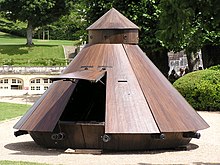

Par pirmo tanka priekšteci var uzskatīt Leonardo da Vinči ap 1487. gadu projektēto kaujas mašīnu, kuru bija plānots apbruņot ar vairākiem lielgabaliem un kustināt ar cilvēka spēku vai zirgiem. Šīs mašīnas konstrukcija nebija paredzēta ātrai pozīcijas maiņai un drīzāk atgādināja pārvietojamo ugunspunktu. Tankam līdzīgu bruņotu mehanizētu transportlīdzekli un tā pielietojumu tranšeju karā aprakstīja Herberts Velss savā novelē "The Land Ironclads" (publicēta žurnālā Strand Magazine 1903 decembrī). Pirmā pasaules kara priekšvakarā, 1911. gadā, neatkarīgi viens no otra, Austrijas virsnieks Ginters Burstins un būvinženieris Lancelots de Molē izstrādā savus tanku projektus.
Burstina tanka dizains - bruņota mašīna ar atsperotu piekari un lielgabalu griežamā tornī - bija revolucionārs un mūsdienīgs, bet izgudrotājs saskārās ar nesaprašanos Vīnes Militārajā Tehniskajā Komitejā, kura neredzēja lietderību Burstina aprakstītajā "sauszemes torpēdu laivā". Arī no tehniskā viedokļa tanks bija nepilnīgs, jo tas spēja pārvietoties tikai pa līdzenu virsmu, pie tam, ar ļoti nelielu ātrumu.[4][5]
Ap to pašu laiku, de Molē izstrādāja "bruņotu kāpurķežu mašīnu" un nosūtīja skices Britu Kara Birojam. Kaut arī viņa projektētās mašīnas ražošana netika uzsākta, pēckara Britu atalgojums £965 apmērā un Britu Impērijas ordenis, norāda uz to, ka Lancelota de Molē darbs nebija veltīgs.[5][6]
Landship development, originally conducted by the British Navy under the auspices of the Landships Committee, was sponsored by the First Lord of the Admiralty, Winston Churchill, and proceeded through a number of prototypes, importantly among them the Little Willie, designed by William Ashbee Tritton and Walter Gordon Wilson, as the first-ever completed tracked tank prototype vehicle, culminating in the Mark I tank prototype, named Mother.[1]
The "tank" moniker was the consequence of a security strategy during development. Staff was told that the devices were to be water carriers for use in the Middle East. The workers gave the machine the logical nickname "tank" and the name stuck. [1] The first tank to engage in battle was designated D1, a British Mark I, during the Battle of Flers-Courcellette on 15 September 1916.[7]
In contrast to World War II, Germany fielded very few tanks during World War I, with only 15 of the A7V type being produced in Germany during the war.[8] The first tank versus tank action took place on 24 April 1918 at Villers-Bretonneux, France, when three British Mark IVs met one German A7V.
Mechanical problems, poor mobility and piecemeal tactical deployment limited the military significance of the tank in World War I, and the tank did not fulfill its promise of rendering trench warfare obsolete. Nonetheless, it was clear to military thinkers on both sides that tanks would play a significant role in future conflicts.[1]
I pasaules karš
[labot šo sadaļu | labot pirmkodu]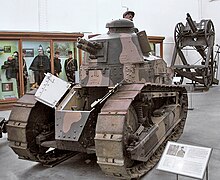
Landship development, originally conducted by the British Navy under the auspices of the Landships Committee, was sponsored by the First Lord of the Admiralty, Winston Churchill, and proceeded through a number of prototypes, importantly among them the Little Willie, designed by William Ashbee Tritton and Walter Gordon Wilson, as the first-ever completed tracked tank prototype vehicle, culminating in the Mark I tank prototype, named Mother.[7]
The "tank" moniker was the consequence of a security strategy during development. Staff was told that the devices were to be water carriers for use in the Middle East. The workers gave the machine the logical nickname "tank" and the name stuck. [1] The first tank to engage in battle was designated D1, a British Mark I, during the Battle of Flers-Courcellette on 15 September 1916.[8]
In contrast to World War II, Germany fielded very few tanks during World War I, with only 15 of the A7V type being produced in Germany during the war.[9] The first tank versus tank action took place on 24 April 1918 at Villers-Bretonneux, France, when three British Mark IVs met one German A7V.
Mechanical problems, poor mobility and piecemeal tactical deployment limited the military significance of the tank in World War I, and the tank did not fulfill its promise of rendering trench warfare obsolete. Nonetheless, it was clear to military thinkers on both sides that tanks would play a significant role in future conflicts.[7]
Starpkaru gadi
[labot šo sadaļu | labot pirmkodu]
In the interwar period tanks underwent further mechanical development. In terms of tactics, J.F.C. Fuller's doctrine of spearhead attacks with massed tank formations was the basis for work by Heinz Guderian in Germany, Percy Hobart in Britain, Adna R. Chaffee, Jr., in the U.S., Charles de Gaulle in France, and Mikhail Tukhachevsky in the USSR. All came to similar conclusions, but in the Second World War only Germany would initially put the theory into practice on a large scale, and it was their superior tactics and French blunders, not superior weapons, that made blitzkrieg so successful in May 1940.[10] For information regarding tank development in this period, see tank development between the wars.
Germany, Italy and the Soviet Union all experimented heavily with tank warfare during their clandestine and “volunteer” involvement in the Spanish Civil War, which saw some of the earliest examples of successful mechanised combined arms—such as when Republican troops, equipped with Soviet-supplied medium tanks and supported by aircraft, eventually routed Italian troops fighting for the Nationalists in the seven-day Battle of Guadalajara in 1937.[11]
II pasaules karš
[labot šo sadaļu | labot pirmkodu]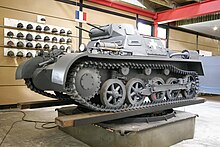

World War II was the first conflict where armoured vehicles were critical to success on the battlefield and in this period the tank developed rapidly as a weapon system. It showed how an armoured force was capable of achieving victory in an unprecedented amount of time. At the same time however, the development of effective anti-tank weaponry demonstrated that the tank was not invulnerable.
Prior to World War II the tactics and strategy of deploying tank forces underwent a revolution. Heinz Guderian, a tactical theoretician who was heavily involved in the formation of the first independent German tank force, said "Where tanks are, the front is", and this concept became a reality in World War II.[12] Following the Invasion of Poland where tanks performed in a more traditional role in close cooperation with infantry units, in the Battle of France deep independent armoured strategic penetrations were executed by the Germans, a tactic later called blitzkrieg or 'lightning war'. Blitzkrieg made use of innovative combined arms tactics and radios in all of the tanks to provide a level of tactical flexibility and power that surpassed that of the Allied armour. The French Army, with tanks equal or superior to the German tanks in both quality and quantity, employed a linear defensive strategy in which the armoured cavalry units were made subservient to infantry as "support weapons".[10] In addition, they lacked radios in many of their tanks and headquarters.[13], which limited their ability to respond to German attacks. In accordance with blitzkrieg tactics, German tanks bypassed enemy strongpoints and could radio for close air support to destroy them, or leave them to the infantry. A related development, motorized infantry, allowed some of the troops to keep up with the tanks and create highly mobile combined arms forces.[10]
The North African Campaign also provided another important battleground for armoured warfare. Due to the desolate terrain

The German invasion of the Soviet Union, Operation Barbarossa, started with the Soviets having a superior tank design, the T-34.[14] A lack of preparations for the Axis surprise attack, mechanical problems, poor training of the crews and incompetent leadership caused the Soviet machines to be surrounded and destroyed in large numbers. However, interference from Adolf Hitler (the main cause),[15] the geographic scale of the conflict, the dogged resistance of the Soviet combat troops, Soviet manpower and production capability prevented a repeat of the blitzkrieg of 1940.[16] Despite early successes against the Soviets, the Germans were forced to up-gun their Panzer IVs, and design and build larger and more expensive Panther and Tiger tanks. In doing so, the Wehrmacht denied the infantry and other support arms the production priorities that they needed to remain equal partners with the increasingly sophisticated tanks, in turn violating the principle of combined arms they had pioneered.[2] In the meantime, soviets responded with their own heavier designs, superior to german Tiger and Panther, namely, IS-2, also, self-propelled anti-tank guns were built to counter german newer tanks.
When entering World War II, America's mass production capacity enabled her to rapidly construct thousands of relatively cheap M4 Medium tanks. A compromise all round, the Sherman was reliable and formed a large part of the Anglo-American ground forces, but in a tank-versus-tank battle was no match for the Panther or Tiger.[17] Numerical and logistical superiority and the successful use of combined arms allowed the Allies to overrun the German forces during the Battle of Normandy. The Sherman Firefly was introduced to improve the M4's firepower, but concerns about protection remained.
Tank chassis were modified to produce flame tanks, mobile rocket artillery, and combat engineering vehicles for tasks including mine-clearing and bridging. Specialised self-propelled guns were also developed: tank destroyers and assault guns were cheap, stripped down tanks carrying heavy guns, often in a fixed hull mounting. The firepower and low cost of these vehicles made them attractive but as manufacturing techniques improved and larger turret rings made larger tank guns feasible, the gun turret was recognised as the most effective mounting for the main gun to allow movement in a different direction from firing, enhancing tactical flexibility.[10]
Aukstais karš
[labot šo sadaļu | labot pirmkodu]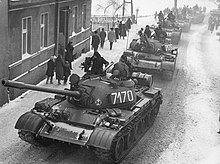
During the Cold War, tension between the Warsaw Pact countries and North Atlantic Treaty Organization (NATO) countries created an arms race that ensured that tank development proceeded largely as it had during World War II. The essence of tank designs during the Cold War had been hammered out in the closing stages of World War II. Large turrets, capable suspension systems, greatly improved engines, sloped armour and large-calibre (90 mm and larger) guns were standard. Tank design during the Cold War built on this foundation and included improvements to fire control, gyroscopic gun stabilisation, communications (primarily radio) and crew comfort and saw the introduction of laser rangefinders and infrared night vision equipment. Armour technology progressed in an ongoing race against improvements in anti-tank weapons, especially antitank guided missiles like the TOW.
Medium tanks of World War II evolved into the main battle tank (MBT) of the Cold War and took over the majority of tank roles on the battlefield. This gradual transition occurred in the 1950s and 1960s due to anti-tank guided missiles, sabot ammunition and high explosive anti-tank warheads. World War II had shown that the speed of a light tank was no substitute for armour and firepower and heavy tanks were as vulnerable as medium tanks to newer weapon technology, rendering them obsolete.
In a trend started in World War II, economies of scale led to serial production of progressively upgraded models of all major tanks during the Cold War. For the same reason many upgraded post-World War II tanks and their derivatives (for example, the T-55 and T-72) remain in active service around the world, and even an obsolete tank may be the most formidable weapon on battlefields in many parts of the world.[18] Among the tanks of the 1950s were the British Centurion and Soviet T-54/55 in service from 1946, and the US M48 from 1951.[19] These three vehicles formed the bulk of the armoured forces of NATO and the Warsaw Pact throughout much of the Cold War. Lessons learned from tanks such as the Leopard 1, M60 Patton series, Chieftain, and T-72 led to the contemporary Leopard 2, M1 Abrams, Challenger 2, C1 Ariete, T-90 and Merkava IV.
Tanks and anti-tank weapons of the Cold War era saw action in a number of proxy wars like the Korean War, Vietnam War, Soviet war in Afghanistan and Arab-Israeli conflicts, culminating with the Yom Kippur War. The T-55, for example, has seen action in no fewer than 32 conflicts. In these wars the USA or NATO countries and the Soviet Union or China consistently backed opposing forces. Proxy wars were studied by Western and Soviet military analysts and provided a grim contribution to the Cold War tank development process.
XXI gadsimts
[labot šo sadaļu | labot pirmkodu]
As of 2005, there were 1,100 M1 Abrams used by the United States Army in the course of the Iraq War, and they have proven to have an unexpectedly high level of vulnerability to roadside bombs.[20] A relatively new type of remotely-detonated mine, the explosively formed penetrator has been used with some success against American armoured vehicles (particularly the Bradley fighting vehicle). However, with upgrades to their armour in the rear, M1s have proven invaluable in fighting insurgents in urban combat, particularly at the Battle of Fallujah, where the Marines brought in two extra brigades.[21] Britain deployed its Challenger 2 tanks to support its operations in southern Iraq.As of 2005, there were 1,100 M1 Abrams used by the United States Army in the course of the Iraq War, and they have proven to have an unexpectedly high level of vulnerability to roadside bombs.[20] A relatively new type of remotely-detonated mine, the explosively formed penetrator has been used with some success against American armoured vehicles (particularly the Bradley fighting vehicle). However, with upgrades to their armour in the rear, M1s have proven invaluable in fighting insurgents in urban combat, particularly at the Battle of Fallujah, where the Marines brought in two extra brigades.[21] Britain deployed its Challenger 2 tanks to support its operations in southern Iraq.
Uzbūve
[labot šo sadaļu | labot pirmkodu]
The three traditional factors determining a tank's effectiveness in battle are its firepower, protection, and mobility. Since the Second World War, the economics of tank production governed by the ease of manufacture and cost, and the impact of a given tank design on logistics and field maintenance capabilities, have also been accepted as important in determining how many tanks a nation can afford to field in its force structure.
No tank design has ever been fielded in significant numbers that proved to be too complex or expensive to manufacture, and made unsustainable demands on the logistics services support of the armed forces. The affordability of the design therefore takes precedence over the field performance characteristics. Nowhere was this principle illustrated better than during the Second World War when two Allied designs, the T-34 and the M4 Sherman, although both simple designs which accepted engineering compromises, were used successfully against more sophisticated designs by Germany which were harder to produce, were more expensive and demanding on overstretched logistics of the Wehrmacht. Given that a tank crew will spend most of its time occupied with maintenance of the vehicle, engineering simplicity has become the primary constraint on tank design since the Second World War despite advances in mechanical, electrical and electronics technologies.
Firepower is the ability of a tank to identify, engage, and destroy a target. Protection is the tank's ability to resist being detected, engaged, and disabled or destroyed by enemy fire. Mobility includes tactical (short range) movement over the battlefield including over rough terrain and obstacles, as well as strategic (long range) mobility, the ability of the tank to be transported by road, rail, sea, or air to the battlefield.
Tank design is a compromise; it is not possible to maximise firepower, protection and mobility simultaneously. For example, increasing protection by adding armour will result in an increase in weight and therefore decrease mobility; increasing firepower by installing a larger gun will force the designer to sacrifice speed or armour to compensate for the added weight and cost. Even in the case of the Abrams MBT which has good firepower, speed and armour, these advantages are counterbalanced by its notably thirsty engine, which ultimately reduces its range and in a larger sense its mobility.
Since World War II tank development has shifted focus from experimenting with large scale mechanical changes to the tank design to focusing on technological advances in the tank's subsystems to improve its performance. However, a number of novel designs have appeared throughout this period with mixed success, including the Soviet IT-1, the Swedish S-tank, the Israeli Merkava, and the incorporation of autoloaders to reduce the crew complement in a number of tanks.
Aizsardzība
[labot šo sadaļu | labot pirmkodu]See also: Anti-tank warfare The British Challenger II main battle tank is protected by Dorchester armour (second-generation Chobham armour)
A tank's protection is the combination of its ability to avoid detection, to avoid being hit by enemy fire, its armour to resist the effects of enemy fire, and to sustain damage and complete its mission, or at least protect its crew. In common with most unit types, tanks are subject to additional hazards in wooded and urban combat environments which largely negate the advantages of the tank's long-range firepower and mobility, limit the crew's detection capabilities and can restrict turret traverse. Despite these disadvantages, tanks retain high survivability against previous-generation rocket-propelled grenades in all combat environments by virtue of their armour. By contrast, tank survivability against newer-generation tandem-warhead anti-tank missiles is a concern for military planners.[22]
Avoiding detection German Panther in a camouflage pattern
A tank avoids detection using the doctrine of CCD: camouflage (looks the same as the surroundings), concealment (cannot be seen) and deception (looks like something else).
Working against efforts to avoid detection is the fact that a tank is a large metallic object with a distinctive, angular silhouette that emits copious heat and noise. Consequently, it's difficult to effectively camouflage a hull-up tank in the absence of some form of cover or concealment (e.g., woods). The tank becomes easier to detect when moving (typically, whenever it is in use) due to the large, distinctive auditory, vibration and thermal signature of its power plant. Tank tracks and dust clouds also betray past or present tank movement. Switched-off tanks are vulnerable to infra-red detection due to differences between the thermal conductivity and therefore heat dissipation of the metallic tank and its surroundings. At close range the tank can be detected even when powered down and fully concealed due to the column of warmer air above the tank and the smell of diesel.
Thermal blankets slow the rate of heat emission and camouflage nets use a mix of materials with differing thermal properties to operate in the infra-red as well as the visible spectrum. Camouflage attempts to break up the distinctive appearance and silhouette of a tank. Adopting a turret-down or hull-down position reduces the visible silhouette of a tank as well as providing the added protection of a position in defilade.
Armour The Tank Urban Survivability Kit for the M1 Abrams is intended to improve survivability in an urban environment American M1A1 Abrams disabled in combat with the Iraqi Tawakalna Republican Guard Division during the Gulf War, February 26 1991, later destroyed by US Hellfire Missile to prevent enemy capture. Main article: Vehicle armour
To effectively protect the tank and its crew, tank armour must counter a wide variety of antitank threats. Protection against kinetic energy penetrators and high explosive anti-tank (HEAT) shells fired by other tanks is of primary importance, but tank armour also aims to protect against infantry antitank missiles, antitank mines, bombs, direct artillery hits, and (less often) nuclear, biological and chemical threats, any of which could disable or destroy a tank or its crew.
Steel armour plate was the earliest type of armour. The Germans pioneered the use of face hardened steel during World War II and the Soviets also achieved improved protection with sloped armour technology. World War II developments also spelled the eventual doom of homogeneous steel armour with the development of shaped-charge warheads, exemplified by the Panzerfaust and bazooka infantry weapons which were lethally effective, despite some early success with spaced armour. Magnetic mines led to the development of anti-magnetic paste and paint.
British tank researchers took the next step with the development of Chobham armour, or more generally composite armour, incorporating ceramics and plastics in a resin matrix between steel plates, which provided good protection against HEAT weapons. Squash head warheads led to anti-spall armour linings, and KEPs led to the inclusion of exotic materials like a matrix of depleted uranium into a composite armour configuration. Reactive armour consists of small explosive-filled metal boxes that detonate when hit by the metallic jet projected by an exploding HEAT warhead, causing their metal plates to disrupt it. Tandem warheads defeat reactive armour by causing the armour to detonate prematurely. Grenade launchers which can rapidly deploy a smoke screen and the modern Shtora soft-kill countermeasure system provide additional protection by interfering with enemy targeting and fire-control systems.
The latest generation of protective measures for tanks are active protection systems, particularly hard-kill countermeasures. The Israeli TROPHY and Iron Fist, the American Quick Kill, the Soviet Drozd, and Russian Arena systems show the potential to dramatically improve protection for tanks against missiles, RPGs and potentially KEP attacks, but concerns regarding a danger zone for nearby dismounted troops remain.
Bruņojums
[labot šo sadaļu | labot pirmkodu]The main weapon of all modern tanks is a single, large-calibre (105 to 125 mm) gun mounted in a fully traversing turret. The typical tank gun is a smoothbore weapon capable of firing armour-piercing kinetic energy penetrators (KEP), also known as armour-piercing discarding sabot (APDS), and/or armour piercing fin stabilised discarding sabot (APFSDS) and high explosive anti-tank (HEAT) shells, and/or high explosive squash head (HESH) and/or anti-tank guided missiles (ATGM) to destroy armoured targets, as well as high explosive (HE) shells for engaging soft targets or fortifications. Canister shot may be used in close or urban combat situations where the risk of hitting friendly forces with shrapnel from HE rounds is unacceptably high.[21]
A gyroscope is used to stabilise the main gun, allowing it to be effectively aimed and fired at the "short halt" or on the move. Modern tank guns are also commonly fitted with insulating thermal jackets to reduce gun-barrel warping caused by uneven thermal expansion, bore evacuators to minimise fumes entering the crew compartment and sometimes muzzle brakes to minimise the effect of recoil on accuracy and rate of fire.
Traditionally, target detection relied on visual selection, namely throughtelescopic periscopes. This is true to this day. In some cases spotting rifles were used confirm proper trajectory and range to a target. These spotting rifles were mounted co-axially to the main gun, and fired tracer ammunition ballistically matched to the gun itself. The gunner would track the movement of the tracer round in flight, and upon impact with a hard surface, it would give off a flash and a puff of smoke, after which the main gun was immediately fired.
Modern tanks also use sophisticated light intensification and thermal imaging equipment to improve fighting capability at night, in poor weather and in smoke. The accuracy of modern tank guns is pushed to the mechanical limit by computerised fire-control systems. A fire-control system uses a laser rangefinder to determine the range to the target, a thermocouple, anemometer and wind vane to correct for weather effects and a muzzle referencing system to correct for gun-barrel temperature, warping and wear. Two sightings of a target with the range-finder enable calculation of the target movement vector. This information is combined with the known movement of the tank and the principles of ballistics to calculate the elevation and aim point that maximises the probability of hitting the target.
Usually, tanks carry smaller calibre armament for short-range defence where fire from the main weapon would be ineffective, for example when engaging infantry, light vehicles or aircraft. A typical complement of secondary weapons is a general-purpose machine gun mounted coaxially with the main gun, and a heavier antiaircraft machine gun on the turret roof. These weapons are often modified variants of those used by infantry, and so utilize the same kinds of ammunition.
Kategorijas
[labot šo sadaļu | labot pirmkodu]- vieglie tanki
- vidējie tanki
- smagie tanki
Skatīt arī
[labot šo sadaļu | labot pirmkodu]Ieteicamā literatūra
[labot šo sadaļu | labot pirmkodu]- Macksey, Kenneth (1976), Tank Warfare, A History of Tanks in Battle, London: Panther, ISBN 0-586-04302-0
- Macksey, Kenneth and Batchelor, John H. (1970), Tank: A History of the Armoured Fighting Vehicle, New York: Scribner, ISBN 0-345-02166-5; ISBN 0-356-03461-5; ISBN 0-684-13651-1
- Ogorkiewicz, Richard M. (1968), Design and Development of Fighting Vehicles, London: MacDonald, ISBN 0-356-01461-4
- Ogorkiewicz, Richard M. (1970), Armoured Forces: A History of Armoured Forces and Their Vehicles, Arms & Armour Press, ISBN 0-85368-049-3
- Ogorkiewicz, Richard M. (1991), Technology of Tanks, Coulsdon, Surrey: Jane's Information Group, ISBN 0-7106-0595-1
- Weeks, John (1975), Men Against Tanks: A History of Anti-Tank Warfare, New York: Mason Charter, ISBN 0-88405-130-7; ISBN 0-7153-6909-1
Atsauces
[labot šo sadaļu | labot pirmkodu]- ↑ 1,0 1,1 1,2 Willmott (2003), First World War Kļūda atsaucē: nederīga
<ref>iezīme; nosaukums "Willmott2003" definēts vairākas reizes ar dažādu saturu - ↑ Barris (2007), Victory at Vimy: Canada Comes of Age April 9-12 1917, p.116
- ↑ Gilbert (1991), Churchill: A Life, p.298.
- ↑ Kenneth Macksey, Tank Facts and Feats, ISBN 0-85112-204-3
- ↑ 5,0 5,1 Guy Hartcup, The War of Invention: Scientific Developments, 1914-18, ISBN 0-08-033591-8
- ↑ Coulthard-Clark, Christopher D., Australian Dictionary of Biography, online edition. Atjaunināts: 2008-08-26
- ↑ Regan (1993), The Guinness Book of More Military Blunders, p.12
- ↑ Willmott (2003), First World War, p.222
Ārējās saites
[labot šo sadaļu | labot pirmkodu]| Vikikrātuvē par šo tēmu ir pieejami multivides faili. Skatīt: Tank |
Latviešu valodā
[labot šo sadaļu | labot pirmkodu]- Panzerkampf.org Latvijas brīvvalsts bruņoto spēku diskusija
- Panzerkampf.org Otra pasaules kara bruņutehnika
- Panzerkampf.org Mūsdienu bruņutehnikas apspriede
Angļu valodā
[labot šo sadaļu | labot pirmkodu]- (angliski) Burnstina tanks Papildus informācijas par Gintera Burnstina Motor-ieroci.
- (angliski) Pirmā pasaules kara tanki
- (angliski) OnWar II. pasaules kara tanki Otrā pasaules kara tanku diagramas un specifikācijas.
- (angliski) Achtung Panzer Vācu tanki un tankisti (1930-1945).
- (angliski) Izcilie PSRS tankisti (1941-1945)
Krievu valodā
[labot šo sadaļu | labot pirmkodu]- (krieviski) Pirmā pasaules kara tanki
- (krieviski) II. pasaules kara PSRS tanku enciklopēdija
- (krieviski) II. pasaules kara un Aukstā kara PSRS tanki
- (krieviski) Mūsdienu tanki un prototipi
- (krieviski) Vasīlija Čobitka bruņutehnikas bibliotēka
